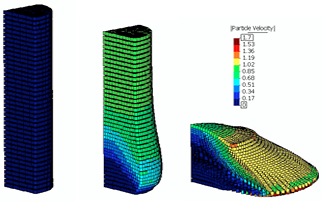Research
Landslide and Debris-Flow Induced Static and Dynamic Loads on Protective Structures
Participants: Carter Mast, WooKuen Shin, Pedro Arduino, Peter Mackenzie-Helnwein andGreg Miller
Landslides and debris flows cause significant damage and loss of life around the world each year. In the US alone, the annual economic costs of landslides can be estimated conservatively to be between $1 and $2 billion, with an associated 25 to 50 yearly casualties. To help protect people, infrastructure, and lifelines against such effects it is critical to have engineered structures that are capable of resisting the loads that are induced during these events. However, determining such loads can be very challenging. Landslides and debris flows are highly dynamic and inherently complex in nature. The true extent of this complexity can be better understood by considering some of the key challenges that arise in attempting to model a landslide or debris flow. A general implementation must include the ability to capture the transitions between solid-like and fluid-like states, phase interaction modeling, appropriate volume constraints, boundary condition generalization, constitutive modeling, all within the context of motions with complexities on many scales. The purpose of this work is to develop a robust numerical modeling framework capable of accommodating these key phenomena with the primary initial goal of predicting loads on protective structures. The basic approach is based on adapting and extending the Material Point Method (MPM), which is well-suited to modeling large deformation, flow-like phenomena.


Contact
Pedro Arduino
132 I More Hall, Department of Civil & Environmental Engineering,
University of Washington, Seattle, WA, 98195-2700. Tel: 206-543-6777, e-mail: parduino@uw.edu